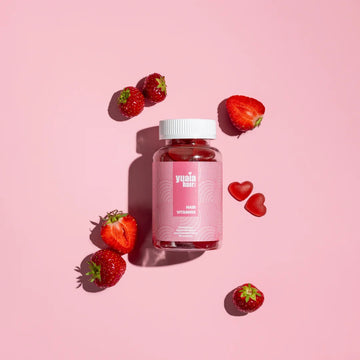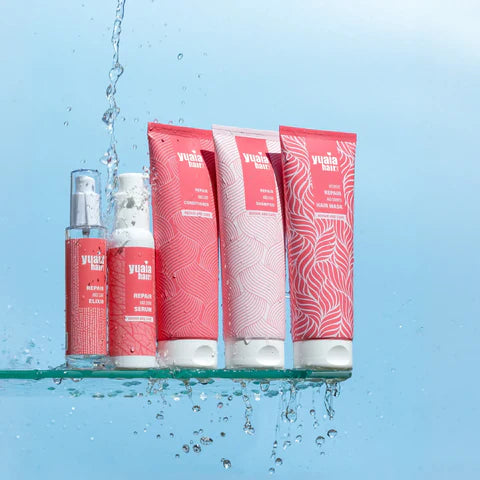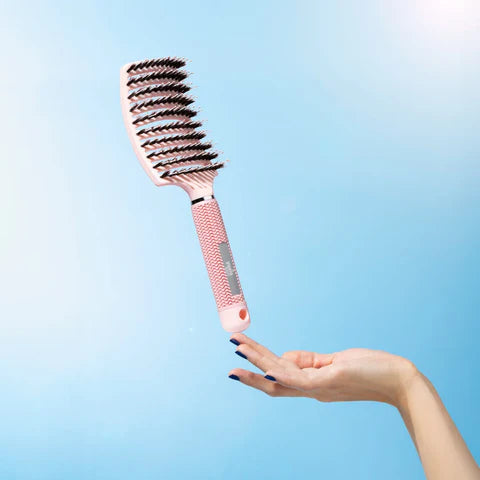

Read through by Dorthe Kristensen
Hairdresser and former co-owner of the award-winning hairdressing chain Zoom by Zoom
With many years of experience in the hairdressing industry, Dorthe has advised many customers about hair and hair care. Dorthe has read through this blog entry to ensure high quality and professionalism. This blog post is professionally updated on April 25, 2025.
Table of contents
Healthy hair does not begin with expensive products or styling routines – it begins at the scalp. Often overshadowed by the focus on hair strands, the scalp is the biological foundation that determines the strength, shine, and vitality of our hair. Just as you wouldn’t expect a plant to thrive in dry, nutrient-poor soil, you shouldn’t expect your hair to flourish if your scalp is neglected.
Why is scalp care important?
The scalp is the foundation of healthy hair. It contains hundreds of thousands of hair follicles, each responsible for producing individual strands. When the scalp is not properly cared for—due to excess oil, product buildup, dryness, or poor hygiene—these follicles can become clogged or inflamed. This can result in issues such as dandruff, irritation, and even premature hair thinning or shedding. Maintaining a clean, balanced scalp environment supports optimal follicle function and encourages stronger, fuller hair growth.
Beyond its role in hair production, the scalp also serves as part of the skin’s natural defense system. It acts as a barrier against environmental pollutants, bacteria, and irritants. If this barrier becomes compromised, it can lead to increased sensitivity, itchiness, redness, and in some cases, infection. Proper scalp care not only promotes better hair health but also helps preserve the skin’s integrity, making it an essential step in any long-term hair care routine.
How to tell if you have a healthy scalp
Recognizing the condition of your scalp is key to determining whether your current care routine is working effectively. A healthy scalp typically has the following characteristics:
-
Balanced oil levels: The scalp feels neither excessively oily nor overly dry. It maintains a natural balance without producing noticeable residue shortly after washing.
-
No itching or irritation: There should be no frequent itching, redness, or discomfort, all of which can indicate underlying inflammation or sensitivity.
-
Absence of dandruff: While occasional dry skin is normal, persistent flaking may point to issues like dandruff or dermatitis.
-
Good circulation: A healthy scalp often appears slightly pink (not red or pale) and responds well to gentle massage, indicating good blood flow.
-
Strong hair growth: Hair that grows evenly and feels thick at the root is often a reflection of a nourished, well-maintained scalp.
If your scalp shows signs of oil imbalance, flaking, or irritation, it may be time to reassess your products and routine. Even minor symptoms can evolve into more persistent problems if left unaddressed.
How often do you actively care for your scalp as part of your hair routine?
How to take care of your scalp
Effective scalp care involves simple but consistent steps that support the skin’s natural balance while promoting follicular health:
Cleansing the scalp properly
Proper scalp cleansing is less about frequency and more about technique. The goal is to effectively remove oil, sweat, product buildup, and environmental pollutants without disrupting the scalp's natural balance. When shampooing, focus on gently massaging the product into the scalp using your fingertips, not your nails. This stimulates circulation and helps lift impurities from the skin and hair follicles. Avoid aggressive scrubbing, as it can lead to irritation, redness, or micro-tears in the skin.
Equally important is choosing the right shampoo for your scalp type. For oily scalps, look for clarifying formulas; for dry or sensitive skin, opt for gentle, moisturizing ingredients. Avoid shampoos with harsh sulfates, parabens, or alcohols, as these can strip away essential oils and compromise scalp health.
Balancing moisture levels
Just like facial skin, the scalp needs moisture to stay healthy and function properly. A dry and flaky scalp often indicates a weakened protective barrier, which can lead to discomfort, itching, and in some cases even affect hair growth. Gently massaging light, nutrient-rich oils such as argan or jojoba into the scalp once or twice a week can help restore moisture levels and improve skin resilience—especially during the colder winter months.
It's also important to note that even oily scalps can be dehydrated. When the scalp is out of balance, it often produces excess sebum to compensate for the lack of moisture. By providing the right kind of hydration, you can help reduce this overproduction and create a healthier, calmer scalp environment that supports overall well-being.
Stimulating blood circulation
Boosting blood flow to the scalp is an essential step in promoting healthy hair growth. Regular scalp massage stimulates circulation, increasing the supply of oxygen and nutrients to the hair follicles. This improved nourishment helps strengthen the roots and may enhance growth over time. Massaging the scalp can be done using your fingertips in gentle, circular motions, either during shampooing or as part of a daily or weekly self-care routine. For added comfort and effectiveness, a soft silicone scalp brush can be used to evenly distribute pressure and gently exfoliate the scalp, encouraging a healthier environment for hair development.
Removing buildup and exfoliating gently
Product residue, pollution, and dead skin cells can accumulate on the scalp over time. A clarifying shampoo used every 2-4 weeks can help remove stubborn buildup. Additionally, gentle scalp exfoliators can be used periodically to cleanse deeply, but these should not be abrasive. The goal is to refresh the scalp, not damage it.
Protecting the scalp from external stressors
The scalp plays a vital role in supporting healthy hair growth, yet it’s often neglected when it comes to protection from environmental elements. Prolonged sun exposure can lead to scalp irritation, reduced follicle function, and weakened hair structure. UV damage may also contribute to dryness and long-term thinning. To safeguard the scalp, especially during extended periods outdoors, it’s advisable to wear a hat or use SPF products designed specifically for the scalp. These protective measures help maintain a balanced scalp environment, which is essential for sustaining strong, resilient hair.
Healthy hair starts at the root
The quality of your hair is a direct reflection of the health of your scalp. While hair products can enhance appearance temporarily, they cannot substitute for a well-nourished scalp. By adopting a scalp-first approach to haircare – grounded in proper cleansing, hydration, stimulation, and protection – you build the ideal environment for consistent, long-term hair vitality. Scalp care is not a luxury; it is the essential first step toward truly healthy hair.
Get a 10% discount code sent to you
Receive the best tips and tricks for your hair from Lotte and Nanna 🥰
 2-5 day delivery
2-5 day delivery
 25.000+ satisfied customers
25.000+ satisfied customers
 Satisfaction Guarantee
Satisfaction Guarantee













